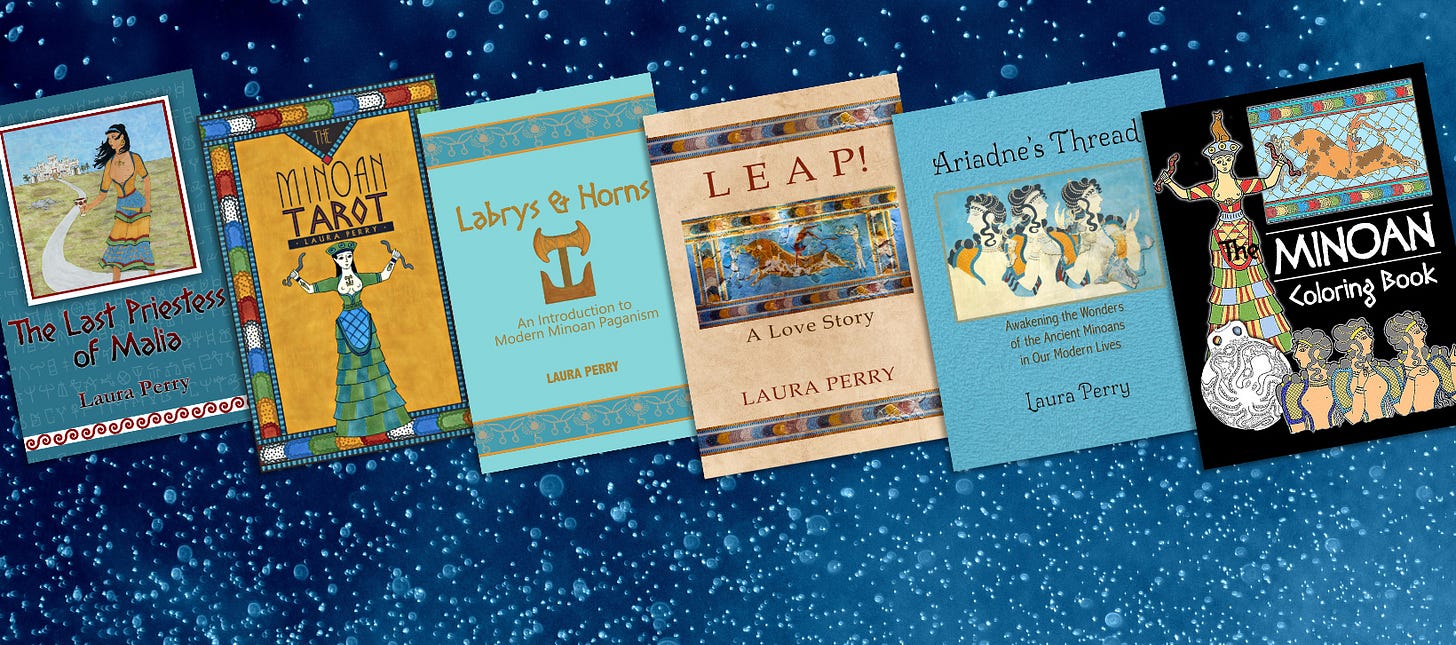The photo above shows an object that was excavated from the Minoan temple complex in Knossos in the early 20th century. Sir Arthur Evans, who was in charge of the excavations, identified it as a candlestick. A number of other similar objects were found at Knossos and other Minoan sites and, following Evans’s example, likewise labeled as candlesticks.
It turns out the Minoans didn’t have candles.
Those “candlesticks” are fancy pedestal oil lamps. It’s actually a clever design; the height plus the double-wick setup throws a lot of light around a room. You can see the two grooves for the wicks in the photo above.
I’ve shared some examples of Minoan oil lamps plus info about how they were used in today’s Minoan Path blog post: Let there be light!
Of course, Evans’s identification of this object as a candlestick wasn’t unreasonable. I mean, it would be a bloody big candlestick - it’s half a meter tall and made of thick, very heavy stone. But with the Victorian Era only recently ended in 1901, Evans would have seen his share of unnecessarily large and ornate candlesticks, so this probably didn’t seem odd to him.
It took a long time for people to figure out that the Minoans didn’t have candles. In fact, it took the discovery of dozens of smaller stone and ceramic oil lamps, ones that look more like what we usually think of when someone says “oil lamp,” for it to sink in that this was indeed how the Minoans had lit their rooms.
What made it especially hard for people to come to this realization is that the Minoans had the makings for candles: beeswax and linen cord.
If they had the materials, why didn’t they make candles? Why weren’t candles invented until many centuries after the Minoans were gone?
That’s a question that still puzzles anthropologists, and it’s part of a larger set of questions that all boil down to this one:
What does it take for us to get a bright idea and invent something new out of materials that we’ve had for a long time?
When new materials appear on the scene, of course that’s going to spur new inventions. But what about new uses for old stuff?
I’ve been fascinated by this aspect of human behavior since I saw the BBC TV series Connections in high school and eventually read the book. In both, science historian James Burke traced the web of unexpected connections that led to a wide variety of brilliant and helpful inventions. Later on, I found The Pinball Effect, another of Burke’s books exploring the way inventions are inspired by seemingly unconnected objects, events, and ideas.
It’s hard to predict what will or won’t spur new ideas using materials and skills we already have available. The issue of cost is one obvious factor. For millennia, beeswax was a rare and expensive commodity, so people weren’t exactly falling all over themselves to come up with new uses for it. Even once candles were finally invented, they remained luxury items available only to the wealthy for a long time.
The desire for ease factors in, too. The shift from the washpot to the molly tub to the manual wringer-washer to the electric washing machine follows the thread of lowering labor (and increasing price, of course!).
And there’s always the urge to just play around and see what we can come up with, whether we’re motivated by a wish to have a new item or a new way to do things, or simply want to see what crazy idea we can come up with, using what’s available.
There have always been inventors, and they’ve often had patron or Benefactor deities or saints. In Ariadne’s Tribe, we have an inventor-god in our pantheon; you might recognize the name Daedalus. Inventing is perhaps a sacred activity, a kind of creation that reflects the creation of the cosmos by deities or its self-creation as a conscious or sentient substance.
The Minoans were a Bronze Age people, but the compulsion to invent surely goes back into the earliest days of humanity, in the Paleolithic, or perhaps even back to our hominin ancestors.
We’ve always liked tinkering, seeing what will happen if we try something new. Yes, the less wise version of this is the “Here, hold my beer” gene. But overall, I think it’s a good thing (minus the capitalist urge to continually extract resources from nature and profits from humans).
What would you invent if you could, some tool or item or gadget that you’d like to use and share?
About Laura Perry
I'm an author, artist, and creator who works magic with words, paint, ink, music, textiles, and herbs. I'm the founder and Temple Mom of Ariadne's Tribe, an inclusive Minoan spiritual tradition. My spiritual practice also includes spirit work and herbalism through the lens of lifelong animism. I write Pagan / polytheist non-fiction and fiction across several different subjects and genres. I'm currently working on an illustrated book of modern Minoan myths. I’m also an avid gardener and living history demonstrator.
You can find my books and Tarot deck on my website, where you can also find my social media links.







Yeah, I've got a chapter in Pagan Portals Candle Magic on the history of candlemaking. Although some ancient civilisations, including the Chinese, had something like candles, in Europe, it wasn't until the Roman era that candles were made. The Romans loved giving candles to each other as Saturnalia gifts apparently, they were the new fashonable thing to have.
Very interesting. I've heard several times that when the time for a new invention has come, often different people in different places come up with versions of it around the same time. It's a case of "the invention of x is in the air".